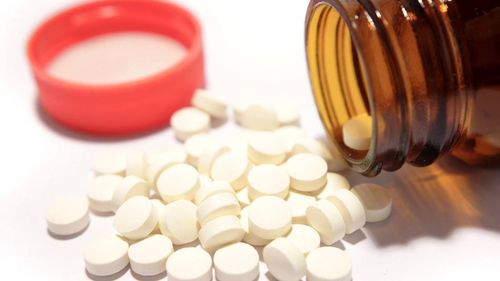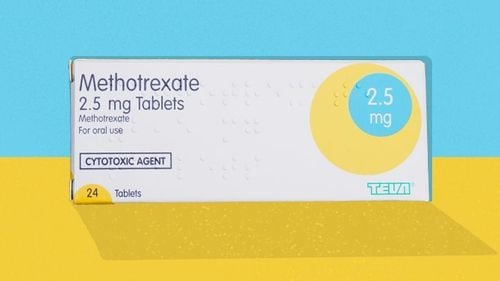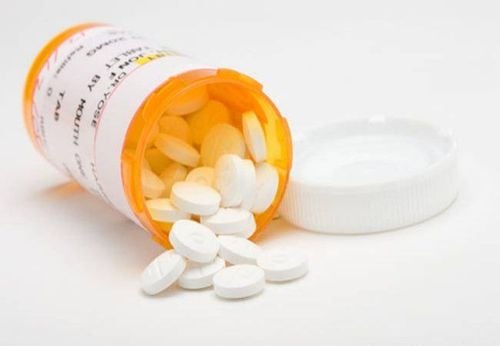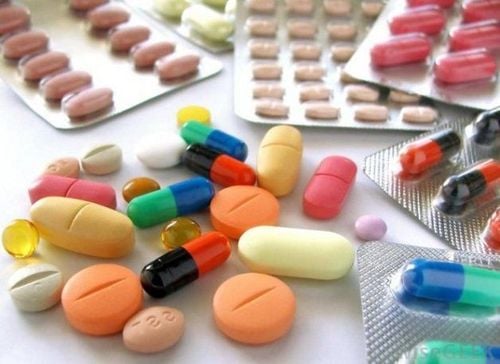This is an automatically translated article.
Predstad 20mg drug has the main ingredient is Prednisolone. Predstad 20mg is indicated in the treatment or suppression of immune disorders caused by inflammation or allergies. To ensure effective use, patients need to take the drug according to the prescription or consult a doctor, a specialist pharmacist.
1. What is Predstad 20 mg?
Predstad drug has the main active ingredient is Prednisolone with a strength of 20mg. The drug is prepared in the form of water-dispersible tablets, white round tablets, one side engraved with a smooth side.
Prednisolone is a synthetic adrenocortical steroid with the essential properties of a glucocorticoid, some of which produce the physiological effects of endogenous glucocorticoids. The effects of Prednisolone include: increased glycogen synthesis, increased hepatic glycogen storage, inhibition of glucose utilization, antagonism of insulin action, increased protein catabolism leading to negative nitrogen balance, increased lipolysis, redistribution of body fat, increasing glomerular filtration rate leading to increased urinary excretion of urate, decreased intestinal calcium absorption and increased renal excretion of calcium. Prednisolone stimulates bone marrow erythropoiesis and neutrophils, but reduces eosinophils and lymphocytes. Other effects of glucocorticoids are only obtained when the therapeutic dose is higher than the physiological dose. At these high therapeutic doses, glucocorticoids are used for both therapeutic and diagnostic purposes, due to their ability to inhibit the normal secretion of adrenal hormones. At physiological doses, glucocorticoids have immunosuppressive, anti-inflammatory and effects on the blood and lymphatic systems, used in the temporary treatment of various diseases. Prednisolone inhibits the inflammatory process and the later stages of wound healing. Prednisolone's anti-inflammatory mechanism is to help stabilize the lysosomal membrane of leukocytes, prevent the release of acid hydrolase that destroys leukocytes and inhibit the concentration of macrophages at the inflammatory site, reducing the adhesion of leukocytes to the capillary endothelium. Prednisolone reduces vascular permeability and edema, reduces complement composition, antagonizes histamine activity and releases kinin. Besides, Prednisolone reduces fibroblast proliferation, collagen deposition and scar formation in the later stages. Prednisolone suppresses the immune system by reducing the activity and volume of the lymphatic system, reducing the number of lymphocytes, reducing immunoglobulins and complement concentrations, reducing the immune complex across membranes, reducing the reactivity of the immune system. tissue with antigen-antibody interactions. Prednisolone can stimulate the secretion of various components of gastric juice. Prednisolone has weak mineralocorticoid activity, increasing intracellular sodium retention and potassium loss. This leads to sodium retention and increased blood pressure.
2. Indications and contraindications of Predstad 20mg
IndicationsPredstad 20mg is indicated for the treatment or suppression of immune disorders caused by inflammation and allergies.
Contraindications
Predstad 20mg is contraindicated in the following cases:
Patients who are allergic or hypersensitive to Prednisolone or any of its ingredients. The patient has a severe infection, except for septic shock and tuberculous meningitis. Skin infections caused by viruses, tuberculosis, fungi. Live attenuated vaccines. Chickenpox. Acute keratitis caused by Herpes simplex.
3. How to take Predstad 20mg
Predstad 20mg orally, disperse Predstad tablets in a little water and drink. Patients need to take Predstad daily dose in the morning after eating, to help limit inhibition of the hypothalamic-pituitary-adrenal axis and reduce unwanted effects.
Dosage of Predstad 20mg: Starting dose: varies from 5 to 60mg or more. Depending on the medical condition and the response of the patient requiring treatment
Dose guidelines for certain conditions:
Follow only the following dosage recommendations for corticosteroid-responsive disorders. For acute or severe disease, a high initial dose can be used and then reduced to the lowest effective maintenance dose as soon as possible. During long-term treatment, the dose of Predstad 20mg should not be reduced to more than 5 - 7.5mg/day.
Allergies and skin disorders: starting dose 5 - 15mg/day. Colloid disease: starting dose of 20-30mg/day. Patients with more severe symptoms may receive higher doses. Rheumatoid Arthritis: Initial dose 10 - 15 mg/day, use the lowest maintenance dose corresponding to moderate relief of symptoms. Blood Disorders and Lymphoma: Initial dose of 15-60 mg/day, usually reduced after satisfactory clinical or hematological response. Higher doses may help in remission of acute leukemia Predstad 20mg in children:
For children in special indications use Prednisolone and use the lowest dose for the shortest time possible. Often based on the condition of the disease and the clinical response of the pediatric patient rather than using a realistically appropriate dose division. Every other day dose is more appropriate for children if it can be adjusted. Use in the Elderly: Treatment of elderly patients, particularly if long-term treatment is warranted, must always be in the light of the more serious consequences of the side effects common to corticosteroids in the elderly. Using the lowest effective dose of Predstad for the shortest time helps to minimize unwanted effects. During the use of corticosteroids, the following treatment guidelines should be adhered to:
Corticosteroids help relieve symptoms thanks to their anti-inflammatory effects, but do not have a curative effect. The appropriate dose for each patient must be determined by trial-and-error. Accordingly, the dose must be re-evaluated regularly according to disease status and treatment response. Long-term use of corticosteroid therapy and increasing dose increases the incidence of undesirable effects. The initial dose should be maintained or adjusted until the desired therapeutic response is achieved. Reduce dose gradually to the lowest dose that maintains the desired clinical response. Using the lowest effective dose of corticosteroid medication helps reduce unwanted effects. With long-term use of drugs, the dose may be temporarily increased during stress or during an exacerbation of the disease. If an adequate clinical response to Predstad is not achieved, patients should gradually discontinue Predstad and switch to alternative therapy. Intermittent Dosing: Some patients respond to a single dose of Predstad in the morning every other day or at intervals. Applying this treatment regimen, helps to limit the inhibitory effect on the pituitary-adrenal gland.
Overdose of Predstad 20mg and management Symptoms of overdosage with Predstad 20mg often occur with prolonged use such as Cushing's syndrome, osteoporosis, muscle weakness, stomach ulcers, adrenal insufficiency.
Management of acute overdose: limit absorption of Predstad by gastric lavage or induce vomiting immediately, then give symptomatic supportive treatment.
In case of chronic overdose, consideration should be given to discontinuing or discontinuing Predstad. If the patient is seriously ill, the glucocorticoid must be continued, the dose of Predstad should be reduced temporarily or every other day.
4. Undesirable effects when using Predstad 20mg
The incidence of predictable adverse events, including suppression of the hypothalamic-pituitary-adrenal axis, correlates with relative drug potency, dose, timing of administration, and duration of treatment. treat. Accordingly, side effects often occur when taking high doses and long-term Predstad. Common side effects of prednisolone include fluid retention, increased blood pressure, changes in glucose tolerance, changes in mood and behavior, appetite, and weight gain. Besides, side effects also affect the organs in the body as follows:Psychiatric, central nervous system: headache, dizziness, irritability, suicidal thoughts, depressed mood and no stability, depression, psychotic reactions, paranoia, mania, hallucinations and aggravation of schizophrenia. Behavioral disturbances, anxiety, irritability, sleep disturbances, cognitive dysfunction including confusion and forgetfulness. Can occur in adults and children. Immune system: allergic reactions including anaphylaxis, angioedema. Infections and parasitic infections: opportunistic infections, increased susceptibility and severity of infections, esophageal candidiasis, recurrence of latent tuberculosis. Endocrine: suppression of the hypothalamic-pituitary-adrenal axis, Cushing's syndrome, symptoms of latent diabetes, decreased carbohydrate tolerance with increased need for antidiabetic therapy. Metabolism, nutrition: sodium and water retention, hypokalemic alkalosis, potassium loss, negative nitrogen and calcium balance, protein catabolism. Increased appetite, weight gain, obesity. Dyslipidemia. Increased intracranial pressure with papilledema (pseudotumor brain) occurred after discontinuation of treatment with Prednisolone. Aggravation of epilepsy, epidural fat accumulation, basilar artery stroke. Eyes: glaucoma, papilledema, cataracts (especially in children), posterior subcapsular cataracts, thinning of the cornea or conjunctiva, protrusion, exacerbation of viral or fungal eye disease . The drug may exacerbate bullous exudate retinal detachment, worsen or lose vision in central serous chorioretinopathy. Cardiovascular: hypertension, congestive heart failure, increased risk of heart failure, increased risk of cardiovascular diseases, including myocardial infarction when treated with high doses of the drug. Embolism, vascular thrombosis. Gastrointestinal: dyspepsia, nausea, abdominal pain, abdominal distention, diarrhea, esophageal ulceration, peptic ulcer with possible perforation and bleeding, acute pancreatitis. Skin and subcutaneous tissue: acne, hirsutism, increased sweating, skin atrophy, striae, skin bruising, capillary dilation, pruritus, rash, urticaria. Musculoskeletal, connective tissue: muscle weakness, myalgia, osteoporosis, vertebral and long bone fractures, avascular osteonecrosis, tendon diseases, tendon rupture. Reproductive system: menstrual disorders, changes in sperm motility and quantity. Discontinuation symptoms:
After prolonged corticosteroid therapy, abrupt dose reductions can lead to acute adrenal insufficiency, hypotension and death. Steroid "discontinuation syndrome" that does not appear to be related to adrenocortical insufficiency can occur with abrupt discontinuation of corticosteroids, including symptoms such as headache, coma, fever, loss of appetite, nausea, vomiting, desquamation, itchy and painful skin nodules, myalgia, arthralgia, rhinitis, conjunctivitis, weight loss or hypotension. The cause is thought to be a sudden change in glucocorticoid levels rather than a decrease in corticosteroid levels. Some psychological effects have also been reported when corticosteroids are discontinued.
Instructions on how to manage unwanted effects:
Long-term treatment with Predstad may cause inhibition of the hypothalamic-pituitary-adrenal axis. The dose of Prednisolone should be reduced gradually rather than abruptly stopping it. A dose reduction procedure can be applied: every 3 to 7 days reduce 2.5 to 5 mg, until a physiological dose of prednisolone is reached of approximately 5 mg. If the patient's condition worsens with a decrease in the dose, the dose of prednisolone may be increased again and then the dose reduced more slowly. Taking a single dose throughout the day causes fewer side effects than dividing it into several small doses throughout the day. Alternating therapy is also a good way to minimize adrenal suppression and reduce side effects; Take a single dose every two days in the morning. Prophylaxis of gastric and duodenal ulcers with high doses of systemic corticosteroids by using H2 antihistamines, proton pump inhibitors. Patients on long-term glucocorticoid therapy require additional calcitriol, calcitonin and calcium supplements to prevent osteoporosis.
5. Note when using Predstad 20mg
Note when using Predstad 20mg as follows:Before starting long-term treatment with Predstad 20mg, it is necessary to check blood pressure, electrocardiogram, chest and spine X-ray, glucose tolerance test and Assess hypothalamic-pituitary-adrenal axis function for all patients. Prednisolone may cause hyperadrenocorticism or suppression of the hypothalamic-pituitary-adrenal axis, especially in children and in patients receiving high doses for a long time. When discontinuing Prednisolone, caution should be exercised and the dose should be reduced gradually. Patients should be warned about the possibility of serious psychiatric adverse reactions to Predstad. Symptoms usually appear within a few days or weeks of starting treatment. The risk is increased with higher systemic doses. Most of the symptoms are reversible upon dose reduction or discontinuation of therapy, in some cases requiring specialized treatment. Notify your doctor if any worrisome psychological symptoms or mental disturbances appear. Predstad 20mg should be used with caution and frequent patient monitoring in patients with the following conditions: diabetes mellitus or a family history of diabetes; glaucoma ; hypertension, congestive heart failure, thromboembolic disorders, recent myocardial infarction; liver failure, kidney failure; thyroid disease; epileptic; Osteoporosis; history of affective disorder, history of corticosteroid-induced psychosis; gastrointestinal ulcers; myasthenia gravis, muscle weakness, myalgia; tuberculosis, chickenpox, measles. Predstad 20mg suppresses the inflammatory and immune response, thereby increasing susceptibility to infection and its severity. The clinical presentation is usually an increased risk of secondary infection; mask atypical and severe infections such as sepsis and tuberculosis, causing the disease to progress to an advanced stage before it is detected; prolong or worsen viral infection, or decrease response to vaccines. Adrenal cortical atrophy develops with long-term administration, which may persist for many years after discontinuing treatment. Patients undergoing surgery may require a temporary increase in the dose of Prednisolone. In some cases where corticosteroids are discontinued after prolonged therapy, a temporary reintroduction of the drug may be necessary. Use in Children: Corticosteroids may cause irreversible growth retardation during infancy, childhood, and adolescence. Avoid long-term use with pharmacological doses. If long-term therapy is required, treatment should be limited to a minimum of hypothalamic-pituitary-adrenal axis suppression and growth retardation. Closely monitor the child's growth and development. infants and young children. When possible, prednisolone should be treated with a single dose every other day. Use in Elderly: Caution and precaution are common serious side effects, especially osteoporosis, hypertension, diabetes mellitus, hypokalemia, susceptibility to infection and thinning of the skin. Subclinical monitoring to avoid life-threatening reactions. Pregnancy: The ability of corticosteroids to cross the placenta varies between types, however approximately 88% of prednisolone is inactivated by the placenta. There is no evidence that corticosteroids increase the incidence of birth defects such as cleft palate or cleft lip in humans. However, long-term or repeated use of corticosteroids during pregnancy may increase the risk of intrauterine growth restriction. It is theoretically possible that infants may experience hypoadrenalism when exposed to prenatal corticosteroids. However, the disease usually resolves spontaneously after birth and does not cause clinically important effects. Therefore, Predstad should only be used when the benefits to the mother and baby outweigh the risks. Patients with normal pregnancy can be treated with the same dose of corticosteroids as nonpregnant. Pregnant patients with preeclampsia or fluid retention should be closely monitored. Lactation: Prednisolone may be excreted in human milk in amounts as small as 5-25% of maternal serum concentrations. However, doses of prednisolone up to 40 mg/day are unlikely to cause systemic effects in neonates. Long-term maternal use of high doses of Prednisolone may affect the development and production of endogenous corticosteroids in the infant. Weighing the benefits and risks of drug use, it is best to use the lowest dose of Prednisolone that is clinically effective.
6. Drug interactions
Predstad is an inducer of cytochrome P450 enzyme, is a substrate of the enzyme P450 CYP 3A, therefore Prednisolone affects the metabolism of cyclosporin, Phenytoin, Phenobarbital, Carbamazepine, Ketoconazole, Rifampicin, Erythromycin. Phenobarbital, Phenytoin, Rifampicin and hypokalemic diuretics decrease the potency of Prednisolone. Prednisolone can cause hyperglycaemia, so a dose of antidiabetic medication is required. Non-Steroidal Anti-Inflammatory Drugs (NSAIDs): Avoid concomitant use with Predstad due to possible gastric ulcer. Amphotericin increases the risk of hypokalemia, therefore concomitant use with corticosteroids should be avoided. Ritonavir increases the plasma concentration of Predstad. Cardiac glycosides: increased drug toxicity and risk of cardiac arrhythmias if hypokalemia occurs with corticosteroids. Methotrexate: Concomitant use with corticosteroids increases the risk of hematologic toxicity. Vaccines: Live attenuated vaccines should not be given to patients with impaired immune response. Antibody response to other vaccines may be reduced. Oestrogens: Oestrogens potentiate the effects of glucocorticoids and dose adjustment is required if oestrogens are added to or withdrawn from the steady-state dosing regimen. Sympathomimetics: There is an increased risk of hypokalemia if high doses of corticosteroids are used with high doses of Bambuterol, Formoteral, Fenotral, Salbutamol and Terbutalin. Predstad 20mg tablet contains the active ingredient Prednisolone. Predstad 20mg is indicated in the treatment or suppression of immune disorders caused by inflammation or allergies. To ensure effective use, patients need to use the drug according to the prescription or consult a doctor, professional pharmacist.
Follow Vinmec International General Hospital website to get more health, nutrition and beauty information to protect the health of yourself and your loved ones in your family.
Please dial HOTLINE for more information or register for an appointment HERE. Download MyVinmec app to make appointments faster and to manage your bookings easily.













